
Bearing Kit, 15123/ 25580 Bearings, 10-36 Seal

Thank you! Your comment has been submitted successfully. You should be able to view your question/comment here within a few days.
Error submitting comment. Please try again momentarily.
- All Info
- Reviews (283)
- Q & A (0)
- Videos (2)
- Photos
etrailer Trailer Bearings Races Seals Caps - BK3-100
- Bearings
- Standard Bearings
- Bearing Kits
- 6000 lbs Axle
- Bearing 15123 and 25580
- etrailer
- Race 25520 and 15245
Trailer Axle Bearing Kit
| Seal | |||
- Bearing Kit Includes:
- One Inner Bearing and Race
- One Outer Bearing and Race
- Grease Seal
- Cotter Pin
BK3-100 Bearing Kit, 15123/ 25580 Bearings, 10-36 Seal
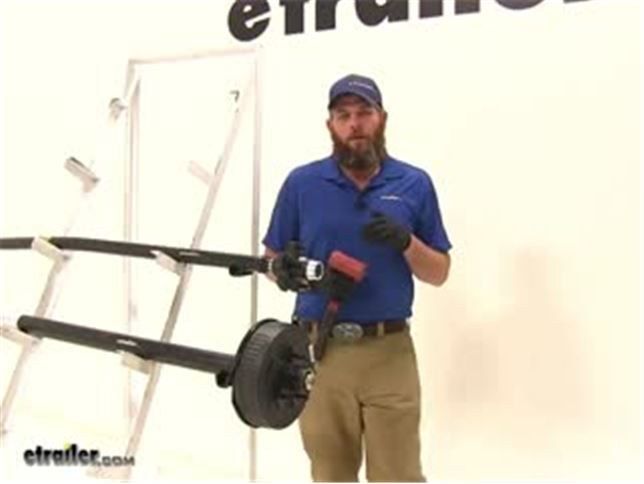

Videos are provided as a guide only. Refer to manufacturer installation instructions and specs for complete information.
Video Transcript for Trailer Bearings Races Seals and Caps Rebuild
Speaker 1: Today we're going to take you through the rebuild process on a couple of hubs. We've got an idler hub, and here we've got a hub and drum assembly. Works with electric rigs, but this can also work for just standard discs, if you've got a disc brake style setup.Basically what we're going to show you is how to get all of the bearings out. How to remove the seal. How to remove the race's if they're damaged, then get them replaced in the proper manner. We'll show you how to use an easy loop hub, which we have here.The first thing we are going to need to do is, get the grease cap off the end.
It can have either a rubber plug in it like this one does, or it can be a solid metal cap.These are pressed fit in there, basically by tapping on them on the back side. To remove them, a deadbolt hammer is typically what we're going to use. We're just going to start tapping as we go around. You'll see a little separation start right here, and slowly it'll work it's way off.Now the next step's going to vary a little bit depending on your axle setup. Do you see this is going to have a keeper that goes around the nut.
And that prevents that from being backed off, or removed. A lot of times you'll have a castle nut, which will have just little tabs that stick off, and there will be a cotter pin that passes through it. Just depending on your application, you need to get the keeper for the nut off. This style we just kind of pry out. A cotter pin you would just remove of course.Once we have that off ...
We'll start to take off the nut here, and the washer that's in behind it. Now yours should look a whole lot more dirty than this. There should be a lot of grease packed in, and through the hub, this one's brand new. We thought it'd be nice to show you the components before the grease was on .. Of our washer that comes off.And then here we're going to have our outer bearing.
Continue to pull that. We're gonig to have our inner bearing here. That sits in the backside of the hub. And we didn't put it in yet, we will show you how to put it in. But a seal would typically be covering the backside here. We'll show you how to use a seal removal tool, or another tool. To get that pried up and out. To get an access to that inner bearing.Now for a drum style like this, that process for disassembly is going to be just the same. One thing to keep in mind if you're using a disc brake setup. You'll have to remove the caliper before the disc is going to come off.Now once we have the spindle exposed, as we said this is going to be really greasy. We want to get all the grease removed, and the first thing we'll do is inspect it. We want to make sure that it looks just like what we have here. Everything's nice and smooth. We don't see any kind of discoloration, or any marring on the metal. Indicating that our bearing's got hot.If you do have any of those symptoms, at this point it's time to replace those bearings. You don't want to repack them. Get new bearings, and put in there. You might have a bearing that's come apart in here. Another surface to ensure is in good condition, is where your seal is going to go. That helps seal all the grease inside of our hub. With a damaged or broken seal, that grease is going to seep out. Either out of the hub, or in this case into our brake assembly.Now if your axle has brakes, we're also going to check the disc. Make sure it doesn't have any issues, or your hub. And this is going to be a hub and drum assembly. The brakes are going to ride on this machine surface. You're going to check that for signs of excessive heat, discoloration, or cracking. And this is our magnet surface. We'll check that surface for the same issues.Now inside the hub regardless if it's a disc brake, it's a drum brake like this. Or just a standard idler style hub. You're going to have an outer race. Would be right here, it's a small tapered piece of metal your bearing sits in, and rotates on. That's basically the outer portion of the bearing.You have the same thing here on the backside. This is called the inner race. Now if those show any signs of wear, overheating, or cracking. Those are also something we'll need to replace, which we'll show you how to do in just a minute.Now, with your brake assembly exposed, if you do have electric brakes like we have here. It's a good idea to check all the components for wear, cracking, maybe missing pieces. Check your pad thickness to make sure those are in good shape. Basically if you have a non working brake assembly and you put everything back together, you're just going to have to take it apart and do it all over again to get back to the brake assembly. This gives you a really good option to be able to change them out.And most applications are going to use a four, or maybe a five bolt flange to hold them in place. And you'll just remove the lock nuts, or sometimes you'll have a hex nut with a lock washer. You want to remove those, and then simply slide your assembly off after you cut the wiring.The friction material itself should also be checked for any kinds of cracking, or overheating. If you have any grease inside the system at all, it's likely it's gotten on those pads. It's a good idea to get those changed. Now as far as the removal of the races go, it's going to be just the same whether we're using an idler style hub like we have here. A drum brake like we have here. You can basically see where the idler is, here in the middle of the hub. It's going to go all the way around there, and we just have this extra material here to provide our braking surface.Now if you're doing a disc brake style job again, it's going to be just the same here with the races living inside of the actual hub portion. You'll just have the discs there for the brakes to make contact. We're going to use this little bit smaller one, it's a little bit easier to manage to show you how to get these out. We've talked about where the races are. The outer here, the inner being closer to the inside, but on the backside of the race there's a little lip. That lip's meant to stick out just a little bit further than the hub, and provide us an area to put our tool on, and help to drive that out.If you look all the way through there on that inner race, you'll see that little lip that sticks out just from the hub slightly, and it gives us enough area to use our tool on. Now generally to remove these you're going to use a punch, similar to this. Some guys will use a screwdriver. Or a piece of pipe. If you have a piece of pipe that's small enough to fit inside of that diameter, you can take that down through and allow it to rest on that lip.Use our punch, and then just need a hammer. And we'll start working that out. We're going to tap all the way around. Kind of equally, and evenly apply the force to get it to come on out of the bottom for us.You can see now as it starts to come out there's going to be a little gap created between the hub and the race. And we can just keep going, bringing it on out. Then you can inspect the inside of the hub surface there. Make sure no damage or anything has occurred, and repeat that same process for the outer race if you plan on removing and replacing that one.Now in the outer flat edge, you can see we're going to have our tapered edge on this side. If we roll our race over to the flat side, typically there's going to be a manufacturers part number on there. That will help you identify which race it is, that you need to go back in your system. If those are rubbed off, worn off, if you can't read them. You can measure the outside, to outside diameter of the race here. It's a good idea to use a micrometer to get it exact.Now here's your basic micrometer. And again, the outside of the race is what we're going to need to measure. You want to go . I set the thickest point there. Looks like this one's going to be about 1.98. That's going to be the measurement you'll want to supply.Now while we've got this out, let's also look at the proper way to measure our bearing. Instead of the outside for the bearing, we need to measure the inside diameter. That's going to be pretty simple. Let's pull that out, find the largest measurement we can. Which here, looks like it's going to be 1.03. With that information, we'll be able to get the correct bearing, and the correct race, so they'll fit together properly and make a full bearing kit for us.Now here's the race, we're going to show you how to get this put back in. Basically just going to press fit inside of our hubs. We need to get it down on there. Kind of like that. And you'll have a couple options. A lot of times you're going to see do it yourself or at homer, just going to use a wooden block. Just place it on there. That's going to get you started, but at that point you'll struggle in getting it to go all the way down into it's seat.Now to take care of that problem, there are several seal drivers that are available. Seal and race drivers that are available out there on the market. It's designed to fit down inside of our race, inside of our hub and get it down there where it needs to go. This is part number ptw83020, has several different sizes, even if you have multiple trailers it's going to do the job.Now the side with the angle on it, is designed to fit down inside of our race. If we use the other side, that's going to be for driving your seal into place. Just want to hold it, and take it on in with your hammer. You'll see, you just want to insure that our race is all the way up against that line on the hub where it's supposed to mate to.Now when it comes time to pack your bearings you're going to have several different ways of doing this. You can just use your hand, is the traditional method. That's going to be the method probably reserved for the very occasional trailer work kind of situation. If you do it once or twice a year, probably get away with it that way.Next you would go to a, kind of a sandwich funnel style almost. If you look inside of there, you can see the bearing. It's located between the two pieces. Just use a grease gun. Start filling that with grease, and that's going to fill our bearing for us. And the third, with this one you're just going to place your bearing down and in. It should be pretty close to center. And then we've got our cone her that's going to go down and secure that.Now I think this style, wastes a little bit more grease than what this style will. This has a dust cap. You can see, you can keep your grease in there, put your dust cap on there and save it for later use. This will be if your going to do it every couple years. And this particular style would be if you're a more regular user.Let's start by showing you how to use a bearing packer. Similar to this. Again, we've just got our grease inaudible 00:11:07 here on the top. And then just slowly start to fill it. Now I like this style quite a bit. I think even regular users might enjoy it, because you can get a really quick visual look at that bearing. You're not going to have to overdo it, or have to much grease.You can kind of see in there now, we're starting to get grease to come out of it. Couple more pumps, we'll be good. You can see we've got grease coming out all the way around. Where all of our bearings are. Got a little bit of excess there. Just take that around the outside of it. And then we should be able to lift it off. And now you can see what we we're talking about. Just a little bit of excess there, that you're just going to wind up wasting.Now we'll take our bearing, we're going to place it right down in our race. And then we'll cap off the back with our seal. Right now our seal's going to fit in just like our race did. It's going to have a little bit of a pressure fit to it. Now very often in this situation, I see people using the four by four method. Kind of here, just placing that on and tapping it. As an option though, if you do have one of these. You can see that's designed to fit right on the top of the seal. And help drive it in.The biggest thing here is, just going to be getting it driven in squarely. You can see, this side's in a little bit further than this side. I'm going to start this side first. Now since we didn't have the opportunity to show you before, we're going to take a look at pulling a seal. Now this is a seal puller, we carry this on our website part number ptw1219. This is meant to hook underneath the seal. And then you kind of pull up on it, and just like our race you'll have to work all the way around that edge. Just bringing it out a little at a time.If you don't have that available. Another option would be a screwdriver. You just kind of get that under the seal, and turn it. And see, that'll allow you to also pop that out. We've taken care of our race. Our inner bearing. Our seal. The last component, before we put our hub back in place is going to be our outer bearing. Now with this bearing, I'll show you the hand packing method.This is definitely . Slightly dirtier method than the bearing packer. When we get grease on our hand we want to look at the larger side of the bearing. This is the smaller side. We have a larger side In between the inside and outside there's a gap. We can see our rollers in there. We want to grab that, and use that gap and shove grease inside of it. Now this is going to take a little bit, you want to work in the same spot until you get the grease pushed all the way through. We can see on the top there we've got a little bit starting to come through.And once we push it in the bottom, and you see it start coming out the of the top in those little drips, it's going to indicate that, that section's fully packed. Just need to work all the way around their outside edge now and do the same thing. Alright, once that's all the way around . The bearing will be ready for use.Now one more thing I like to do. We can see our inner bearing there, and our outer bearing. Well between the two, got a pretty big gap in there. If you'll take a . Pretty good amount of grease. We're just going to go all the way around. See how we can go all the way around the inside and just line that really well. The more grease we have in here, the less chance we have of any moisture getting in there, which can cause corrosion, rust, pitting. Pretty much things we do not like when it comes to bearings, races, and hubs.Put plenty of grease in there. And then this one does have the easy lube spindle, that'll even fill it in more. Now we can get our assembly slid on. I like to keep my thumbs on that outer bearing, just to prevent it from . inaudible 00:15:28 pushed off there. Now we can put on the original hardware that we removed, in taking off our hub the first time. In our case, we had our washer and our nut.Now most commonly you'll see pliers similar to this being used. We basically want to get that tightened down. Once it's fully tightened down you'll feel some resistance in the hub. We back it off just slightly. That'll give us a little bit more freedom of motion there. Something you don't want however . Is any movement in, or out on your hub. You want to be sure that everything is compressed, and you don't have what's called end play. Which would be the play in and out.Once we've got that set, then you'll put on whatever tight keeper yours came with. Get that put back in place. Now with an easy lube style hub, you're going to place your grease gun on the end, and then you can just fill the remainder of that hub up.Now for your typical applications, you're either going to have a solid cap, or a cap that'll have a rubber plug in it. A solid cap's going to be for an axle without the grease inaudible 00:16:51 here on the end. Goes on there. Just knock it on with your rubber mallet. Same with the one with the plug. Just gives you a removable area there, be able to cap that off.We'll show you how to put that on. Now as alternatives as well, a lot of times on boat trailers and marine kind of situations. You'll see a bearing buddy. This is going to apply a little bit of pressure on the grease, you'll fill it up. This kind of comes out just a little bit. That applies constant pressure on the grease to make sure we don't have any air, or anything like that. Then there is also an oil bath hub available. Now this is going to be for use with seals that are going to be designed specifically for oil bath use. You'll have to change that seal.We're using a double lip seal. There are also single lip seals available. Of course a double lip seal is going to give you just a little additional security. Keep that in mind when you order. But let's get this knocked on there now so you can see how that works. We just want to take the cap, we're going to center it. This is going to be very similar to what we did with the seal. And then just gently start tapping it around the outside. And it'll seep down on there for you.It's really going to be the same thing that you'll do with any of the end caps. Now with this side done, it's a good idea to take care of all the other hubs. Get them all on the same maintenance schedule. And as long as you'll periodically check the grease, take your trailer out for a trip occasionally. Just to keep everything lubricated. It should extend the life of these parts, and give us years of good service.
Customer Satisfaction Score:
98% were satisfied with this product
2% of customers were not satisfied
- Wrong item was ordered
- Product did not meet expectations
- etrailer mistake
Customer Reviews
Bearing Kit, 15123/ 25580 Bearings, 10-36 Seal - BK3-100
Average Customer Rating: 4.8 out of 5 stars (283 Customer Reviews)

Had the bearings for a year now and they are working fine, no issues. Bearings looked good when cleaned and re-packed at the end of the summer.

Orders always come in on time. I forgot to check Tracking numbers on my order, turns out I wasn't missing anything, half of it was still in transit. Very reliable vendor and quick responses
My order was received in good shape. Running a large ranch with quite a number of high capacity trailers to maintain, etrailer has the support we need to keep us operational. They are my go to for trailer running gear, because their customer service is second to none in product selection, advice on fit, how to videos, and communication on status of your order. Their prices are quite competitive and I have yet to send anything back after more than 10 years of doing business with them.
Bearings and seal look like they are good quality
Quinn did sn excellent job on my order We compared pricing and informed me as to del8very times, I received email updates and was informed as to when to expect delivery. Oustanding and professional customer service, Highly recommend etrailer your trailer needs.
Was unsure about the size but with your detail description was able to select the correct size. Thanks so much!
Always easy to find the correct parts on your web page. A real person answers when you call for assistance and they provide great guidance.

may cost a little more but I have not had any problems and Drive from Birmingham Al to Panama city beach Fl. at least 6 times a year to put my sea hunt off shore boat in to fish (Salt water) No corrosive at all yet only one flat tire
Thank you for the great service
:)
Great product just wish they were in a package or bag to help stay sealed

Great bearings and seals
Installed perfectly and have about 6000 miles on work trailer and everything is smooth and no leaks
Ordered these for a spare when on the road. Have used them before without any issues. As always with Etrailer ordering was easy and price was good. Arrived quickly and packaged good.

the install was easy and they are holding up just fine. Not used many times but so far all is good.

Seem like good bearings.
Everything you need to replace the bearings on axle. Purchase was easy to figure out what I needed and package showed up timely. Price was super competitive. What I spent to do one hub alongside the freeway was more than doing the other three using etrailer axle bearing kits.
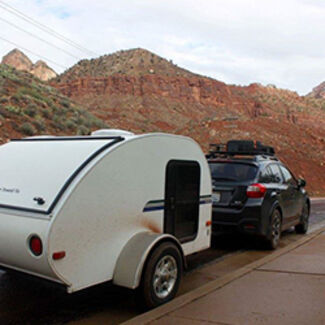
Rusty

11/20/2021
Still working great
great service from start to finish i ordered on the phone very
nice lady was great thank you .
The order came and everything was perfect. I have never had a problem with anything I have ordered from etrailer
My order was delivered quick and exactly what i ordered THANK YOU Ill b back
Always great service and quality parts

One Year Follow-Up - This was an extremely simple and cost effective option to repair my trailer brakes. One side had been contaminated by a leaky grease seal, but I replaced the brake assemblies, seals, bearings, and races on both sides of my single axle fresh water boat trailer at the same time. I estimate about 3000 miles on this trailer since installed and everything is still working great.
Products as advertised, shipping was pr ompt.

Service was great. Packaging of bearings very poor, they were all thrown in a bag and shipped loose in the bag. During shipping some of the races and roller bearings were scratched and i had to buy some bearing and race at the local parts house.


Jenny N.
2/4/2022
I will have our customer service team reach out to you.
made in China is a corrosion concern
I was ready to order a bearing kit since both bearing numbers matched up and the kit included a Seal plus the Spindle Washer. I was unable to locate a number on the seal so when I called to order I was lucky to have Sandy take my order... she knows her stuff. Sure she could of just took my order and gave me what I asked for but she wasn't comfortable not having a seal number and had me go measure it. As I was doing this I located a set of very small numbers on the rubber lip of the seal. I gave her the numbers off the seal and she was able to cross reference it and discovered it was not the same seal for the kit I was about to order. She found the correct kit had the bearings and seal as an exact replacement. Only "issue" we both thought odd was as a kit it didn't include the Spindle Washer where the other kit did. Not a big deal I just ordered the washers too.
I have been a customer of etrailer for many years, always fair pricing, fast shipping, quality products, and a outstanding tech support group.
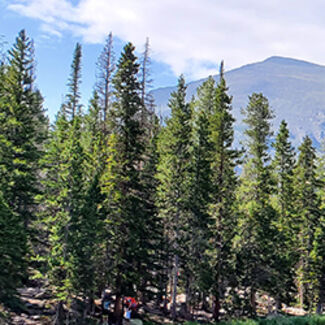
Dennis D.

3/8/2021
Well been 1 year, about 40k miles, just repacked the bearings, still in great shape, replaced seals during repack but all of them were still well sealed, have had great luck with etrailer on every item I have bought over the last 15 years, they are the go to place for everything towing.
See what our Experts say about this etrailer Trailer Bearings Races Seals Caps
- Replacement Bearings/Seals/Races for Dexter P-29 7K AxleAfter quite a bit of searching, I wasn't able to determine which bearings, races and seals were included with the hubs used on your Dexter Axles. You did a great job of providing me with lots of information, which makes my life easier but in this case I couldn't find anything. You'll need to pull one of your hubs, and get the reference numbers from the inner and outer bearing, from which we can determine which races and seals are needed. If you can't make out the reference numbers, you'd...
view full answer... - How To Determine The Correct Bearings, Races, and Seals For 12 x 2 Drum on 5,200-Lb AxleTo determine the correct parts for your 12 x 2 drum on a 5,200-lb axle, you will have to remove the hub from the trailer and either get part numbers from the inner and outer bearing, and grease seal or measure the spindle in 3 places and the hub in two places. I have included a photo showing the places to look for part numbers and places to measure if part numbers are not visible on your bearings and seal. If you need to measure, a dial or digital caliper will be needed to get accurate...
view full answer... - Availability of Bearing Kit with Bearings 25580 and 15123Are you positive that the bearing number you have is 15126? That is not a standard bearing number and based on the other bearing you have it sounds like you would need the part # BK3-100. If the inner diameter of the 15126 is 1.250 and the matching race is number 15245 then you do have the 15123 and the # BK3-100 would be the correct kit.
view full answer... - Will Bearing Kit BK3-100 Replace Lippert Kit 333950Bearing Kit # BK3-100 consists of bearings 15123 and 25580, matching races, grease seal and cotter pin. This kit is intended for a 6K axle. The same component parts are found in Lippert bearing kit 333950, also rated for a 6K axle. Two helpful articles concerning bearings are linked for your reference.
view full answer... - Bearing and Seal Kit for Trailer with 6k AxlesFor a bearing kit that fits your 6k axle you'd want the etrailer # BK3-100 which comes with the correct bearings and seal that matches the dimensions you listed as well. These are the only quality of bearing that's going to fit your trailer. If they are packed with grease and maintained they will last you a long time though.
view full answer... - Bearing Kit With 25580 & 15123 Bearings For Lippert AxleThere's crossover; the 15123 and LM67048 have the same inner diameter, so they fit the same spindle, and often hubs fit both 5,200 lb and 6,000 lb axles. So you are perfectly okay with what you have and the correct replacement bearing kit for 25580 and 15123 is the following: - Bearing Kit, 15123/ 25580 Bearings, 10-36 Seal # BK3-100
view full answer... - Bearing Kit that Fits Dexter 6k Trailer AxleFor a 6k Dexter axle the correct bearing kit would be the part # BK3-100 which comes with bearings, seal, and cotter pin.
view full answer... - Bearing Kit For 6,000 lb Dexter AxlesThe correct replacement bearing kit for a 6,000 lb Dexter axle is the following: - Bearing Kit # BK3-100 This comes with the correct replacement bearings, races, and seal for one hub, so you'd need a quantity of two bearing kits for one axle.
view full answer... - Replacement Wheel Bearings, Races and Seals for a 2010 Jerry James Flat Bed TrailerTo determine the correct parts for your 2010 flat bed Jerry James double-axle trailer with electric brakes, you will have to remove the hub from the trailer and either get part numbers from the inner and outer bearing, and grease seal or measure the spindle in 3 places and the hub in two places. I have included a photo showing the places to look for part numbers and places to measure. If the part numbers are not visible on your bearings and seal a dial or digital caliper will be needed...
view full answer... - Replacement Bearing Kit For Dexter 6,000 lb AxleWe have the bearing kit part # BK3-100 that is designed for Dexter 6k trailer axles like yours. This comes with new bearings and a seal. I attached an install video that shows a trailer hub getting rebuilt for you to check out as well.
view full answer... - Replacement Bearing and Seal Kit for Dexter 6k Trailer AxleThe correct bearing kit for a Dexter 6k trailer axle would be the part # BK3-100 which comes with the correct bearings and seal you are needing. Most of the numbers you mentioned are just serial numbers and capacities but the HF=87 inch is the distance between hub faces and the SC=68.5 is the distance between the spring seats. This is info that is needed if you ever were to have to replace that axle.
view full answer... - Recommended Bearing Seal Kit For 2000 Four Winns TrailerThe 10-36 seal that is included in the # BK3-100 kit will work great on your trailer. This kit comes with the inner bearing and race, outer bearing and race, grease seal and a cotter pin.
view full answer... - Does the Bearing Kit BK3-100 Have a 225337375TB Grease Seal?Yes, it will! The grease seal in the Bearing Kit item # BK3-100 has a 2.250" ID and a 3.376 OD.
view full answer... - Correct Bearing and Seal Kit for Trailer with 6k Dexter AxlesSince your trailer has 6k axles the correct bearing kit is the part # BK3-100 that you referenced. This comes with the two needed bearings, the seal, and a new cotter pin for the castle nut.
view full answer... - Trailer Bearing Kit to Replace a 15123 Outer bearing, 25580 Inner Bearing and 2.125 Inch SealBased on the seal measurement, it sounds as if the best fit is going to be the Bearing Kit, 15123/25580 Bearings,10-10 Seal, # BK3-110. The seal that is included in this bearing kit measures 2.125 (2-1/8) inches. The inner and outer bearing numbers remain the same as the BK3-100 kit you have referenced. You want to be certain to get the correct kit to avoid potential problems down the road. I recommend taking a look at the other set of bearings/seals on the other hub to double check, if...
view full answer... - Replacement Bearing Recommendation for Dexter 6,000 lb AxlesWe have two bearing kits that could fit for your Dexter 6,000 lb axles. The difference is the seal size. The part # BK3-100 is the kit that has the correct bearings and a seal with an inner diameter of 2.25 inches. This is most likely what you need. The other options is the part # BK3-110 which has a grease seal with an inner diameter of 2.125 inches. You would need to measure the outer diameter of the spindle your seal rides on to determine which kit you'd need.
view full answer... - Bearing Kit Recommendation for 6k Lippert Trailer AxlesWe have two bearing kits that would possible work for a Lippert 6k axle. The part # BK3-100 has bearings 15123 and 25580 plus seal 10-36. This would be the kit for if your spindle has a bearing surface that is 2.250 inches. If instead your seal surface is 2.125 inches you would need the part # BK3-110. We don't carry Timken bearings which aren't commonly seen on trailer hubs.
view full answer... - Bearing Kit with 15123 and 25580 Bearings for a 2006 Four Winns Boat TrailerThere are a couple of options that having bearings 15123 and 25580 (the other numbers are the associated races). We have # BK3-100 which includes seal 10-36 which has an inner diameter of 2.250 Inches and outer diameter of 3.376 inches. And we have # BK3-110 which comes with a tang washer and seal GS-2125DL which has an inner diameter of 2.125 inches and outer diameter of 3.376 inches. I have linked videos of both sets for you so you can see all of the included parts.
view full answer... - What Size Bearings are Kits Available For?The best way to find out what kit you need is to find the bearing numbers which should be stamped on the bearing themselves. You will also need to know the grease seal, whose inner and outer diameter you will need to measure with a digital caliper to the thousandths of a decimal point. The weight capacity of your axle would be another telling point to find the correct bearing kit for you. That said, I have broken down our kits based on sizes as you requested. Bearing kit # BK1-100 is for...
view full answer... - Bearing Kit Recommendation for Lippert 6k and 7k AxlesFor a Lippert 6k axle you have two options. The part # BK3-100 and the part # BK3-110. The difference would be the size of the inner diameter of the grease seal. The part # BK3-100 comes with seal that has inner diameter of 2.25 inches and the part # BK3-110 comes with seal that is 2.125 inches. For a 7k axle by Lippert you would want the part # BK3-200 if the seal diameter needed is 2.25 inches or part # BK3-210 for inner diameter of 2.125 inches.
view full answer... - Which Cotter Pin Is Needed for BK3-100 and BK3-200 for 6000-lbs and 7000-lbs AxlesThe size of the cotter pin is going to vary depending on the spindle of each axle. The cotter pin used in the bearing kits we have available for the axle/spindle that you mentioned is the Cotter Pin - 1/8" Thick x 1-3/4" Long # 165649, and while those are not sold in bulk, you can purchase as many as you'd like to keep on hand via the product page. In regards to the maintenance kits, it's not exactly what you've mentioned but we do offer bearing kits for each of these axles that come...
view full answer... - Replacement Bearing Kit for Load Rite Trailer with 12 Inch Kodiak Disc Brake RotorsThe Kodiak 12 inch 6 bolt hub and rotor assemblies we offer would use the # BK3-100 bearing kit. Each kit includes one # 25580 inner bearing, one # 15123 outer bearing, one 10-36 grease seal and a cotter pin. To determine if these are the correct bearings for your application, you will need to pull one of your hub/rotors off and look for the numbers on your inner and outer bearings. The number should be located on the flat, back side of the bearings.
view full answer... - Correct Replacement Bearings for Boat Trailer with Oil Lubrication HubsI do have options for you but we can't look up bearings for any one specific trailer, you'll need to find the axle tag and or pull apart the hubs and find the bearing numbers. Please note, most of our bearings can be used with oil or grease, the seal is what determines oil or grease compatibility. The Bearing Kit part # BK3-100 is designed for 5,200-7,000 lb axles and you can use the Oil Seal part # 9103309 for oil lubrication compatibility.
view full answer... - Replacement Bearing and Grease Seal Kit for a Coachman Chaparral CamperWe have a few different kits for you to check out depending on the weight capacity of your axles and the inner diameter of your grease seal. If you can confirm the weight rating of your axles and the inner diameter of your grease seals then you just need one of the following kits: 2.125" ID Grease Seal: - 5,200 lb Axle # BK3-310 - 6,000 lb Axle # BK3-110 - 7,200 lb Axle # BK3-210 2.250" ID Grease Seal - 5,200 lb Axle # BK3-300 - 6,000 lb Axle # BK3-100 - 7,200 lb Axle # BK3-200
view full answer...
Do you have a question about this Trailer Bearings Races Seals Cap?
Info for this part was:









At etrailer.com we provide the best information available about the products we sell. We take the quality of our information seriously so that you can get the right part the first time. Let us know if anything is missing or if you have any questions.






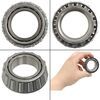
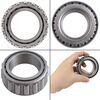






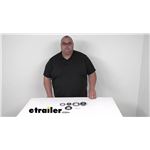















































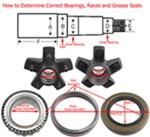

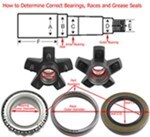

Eric
12/1/2020
Great, installed quickly and working great